In PM Modi’s Bharat, development does not reach anywhere as fast as near a pilgrimage site. In a recent visit to Mathura Uttarakhand’s Chief Minister Pushkar Singh Dhami boasted of the ‘extensive development’ that the country’s religious sites have undergone. While his claim is not off the mark, at what cost are these rapid urbanisation and redevelopment projects being undertaken?
Not long ago the subcontinent was the boiling pot of the opium trade – one of the most powerful agents in our colonial history. While the poppies might be on a decline, our understanding of opium’s relevance to governance has grown stronger as we found the strongest of all opiates – religion. The rebranding of India as Bharat is more than an etymological makeover. Aggressive investment in redevelopment projects around pilgrimage sites is pushing a religious Bharat without any hem and haw. The Prime Minister is increasingly more visible at temples than at press conferences facing microphones.
Aggressive investment in redevelopment projects around pilgrimage sites is pushing a religious Bharat without any hem and haw.
It all started with the Ganga aarti in 2014 and the rest that followed remained consistent with the promise of a religious overhaul. The magnum opus of the saffron agenda is the Ram Mandir, set to be unveiled in December 2024. But it is only one of the many projects the current government has undertaken. The temple corridors of Uttarakhand, Madhya Pradesh and Uttar Pradesh (Mathura) are some of the most important projects rapidly clawing their way through the respective cities’ planning.
As a run-up to the 2019 election, the Kashi Vishwanath corridor project was flagged off in 2018. Around 250 multi-storeyed buildings were razed to the ground to make way for the unrecognisable urbanisation of the area. People who were “in the way” of the religious road had to watch 300 years ’ worth of heritage and history be demolished. Claims of shrines and small temples being destroyed to make this possible were denied by the government. But anyone who has been in Varanasi knows how temples are housed in courtyards and Shiv Lingas dot the narrow lanes. But indeed it is not about religion or people’s faith – it is the face value of these projects. The Vishwanath Corridor in Varanasi, initiated during Modi’s tenure, has been a flagship project aimed at transforming the spiritual landscape of the city. But without taking into account the social impact and displacement associated with large-scale developmental projects – these projects will continue to be the ruling party’s self-serving assignment and not sensible governance.
Now, there is no denying the fact that the erstwhile narrow lanes that led one to Kashi Vishwanath temple were difficult to navigate or access. BJP is not the first party in power to consider solving this problem but no other party had a mandate as swoon-worthy as them, nor did they have a priest-turned-chief-minister heading operations in the state. A few weeks ago, one can guess as a New Year’s Eve announcement, PM Modi announced the second edition of the Kashi corridor along with 37 projects worth over Rs 19,000 crore. One dreads who will have to make way for these developments. The Kashi Tamil Sangamam Express is also set to ply between Kanyakumari and Varanasi. The economic implications of these developments are obvious as the projects draw more tourism into the place, but it is also important to read into the political implications. The southern part of the country continues to be elusive for BJP. While Tamil Nadu continues to deny Modi a space on the throne, this project is a very obvious hand extended to the devouts of the state.
The economic implications of these developments are obvious as the projects draw more tourism into the place, but it is also important to read into the political implications.
Last January the screaming headline across all platforms was the horrifying news of an entire town sinking in Uttarakhand. Joshimath’s subsidence was a slow and inevitable tragedy as the already soft land was forced to be under duress due to multiple development projects around the area. Joshimath’s significance is in its proximity to the Badrinath temple – one of the Char Dhams from the pilgrimage route. The same year that the pictures of cracked houses and roads surfaced, the Char Dham pilgrim count crossed the 50 lakh mark, for the first time. What projects put so much pressure on the town of Joshimath besides the tsunami of devotees increasing every year? Well, the influx of tourists calls for urban development standards. Despite the findings of two committees appointed by the Supreme Court, which indicated a considerable environmental impact from hydroelectric power projects, the government proceeded in 2015 to establish a new committee that approved a minimum of six such projects. To add insult to injury Tapovan Vishnugad Hydroelectric Power Project was one of the plants heavily damaged during the 2021 floods in the Chamoli district. Joshimath, housed in Chamoli, bore the brunt of both the road development and power plant projects that were expedited by the current government to keep its modus operandi on track. Unplanned, rather unadvisable, urbanisation and infrastructure projects can have severe consequences, necessitating a balance between development and environmental sustainability.
The BJP’s religious agenda raises questions about the delicate balance between fostering spiritual tourism and preserving the intrinsic cultural and environmental values associated with these pilgrimage sites. The government’s plan to develop 14 religious sites as tourist destinations underlines a broader strategy to boost religious and thematic tourism. This approach raises questions about the balance between development goals and the preservation of the sanctity of religious sites.
The government’s plan to develop 14 religious sites as tourist destinations underlines a broader strategy to boost religious and thematic tourism.
A 2020 report highlights the challenges faced by cities like Varanasi, Ujjain, and Ayodhya in coping with the surge of devotees due to a temple boom. This surge has put pressure on infrastructure, necessitating thoughtful urban planning to manage the influx of pilgrims without compromising the cities’ essence. Discontent among locals in Varanasi was reported due to the perceived loss of homes and the demolition of iconic structures during the development of the Kashi Corridor. This underscores the need for inclusive development that takes into account the concerns of the affected communities.
The signing of an MoU for a ‘Riverine Based Religious Tourism Circuit’ in May 2023 indicates a broader trend of linking religious sites through tourism circuits. While this can boost economic activities, it also raises questions about the environmental impact on river ecosystems and the A 2023 analysis highlights a significant growth in spiritual tourism in India. This growth, while positive for the economy, underscores the importance of managing the associated urbanisation and development to avoid negative impacts on cultural and natural heritage. Concerns were also raised in Jammu and Kashmir over road construction to Amarnath Cave, illustrating the delicate balance required between facilitating pilgrimage and preserving the fragile ecosystems of religious sites.
As we talk of the destruction of history and the rebranding of new religiosity – there is some merit in looking at the other end of conserving religious sites. Two reports from 2019 show the possibility of preserving biodiversity through sensible conservation. Bangalore undergoing rapid and destructive urbanisation has been able to keep open-air tree shrines intact – triggering the conservation of 121 species of trees. This has also lent to cultural heritage and vice versa. Similarly in Kerala the practice of sacred groves has aided in the conservation of endemic ecosystems – from flora to the bird species of that area.
In the intricate web of BJP’s religious agenda, one can’t help but notice a theatrical performance where the script revolves around the urbanisation of pilgrimage sites. The party’s grand productions, such as the Kashi Vishwanath Corridor, seem more concerned with photo ops than the preservation of cultural sanctity. Despite two Supreme Court-appointed committees flagging environmental concerns, the government’s response was to set up yet another committee, illustrating a knack for bureaucratic theatrics rather than genuine environmental stewardship. As sacred sites transform into construction zones, one might wonder if the BJP’s religious agenda is more about political posturing than a sincere commitment to the welfare of both the spiritual and physical landscapes it claims to cherish. The irony is as glaring as the neon lights adorning their urbanised pilgrimage corridors, a stark reminder that in this saga, the narrative may be more ‘epic fail’ than ‘epic tale.’
About the author(s)
She/they is an editor and illustrator from the suburbs of Bengal. A student of literature and cinema, Sohini primarily looks at the world through the political lens of gender. They uprooted herself from their hometown to work for a livelihood, but has always returned to her roots for their most honest and intimate expressions. She finds it difficult to locate themself in the heteronormative matrix and self-admittedly continues to hang in limbo







